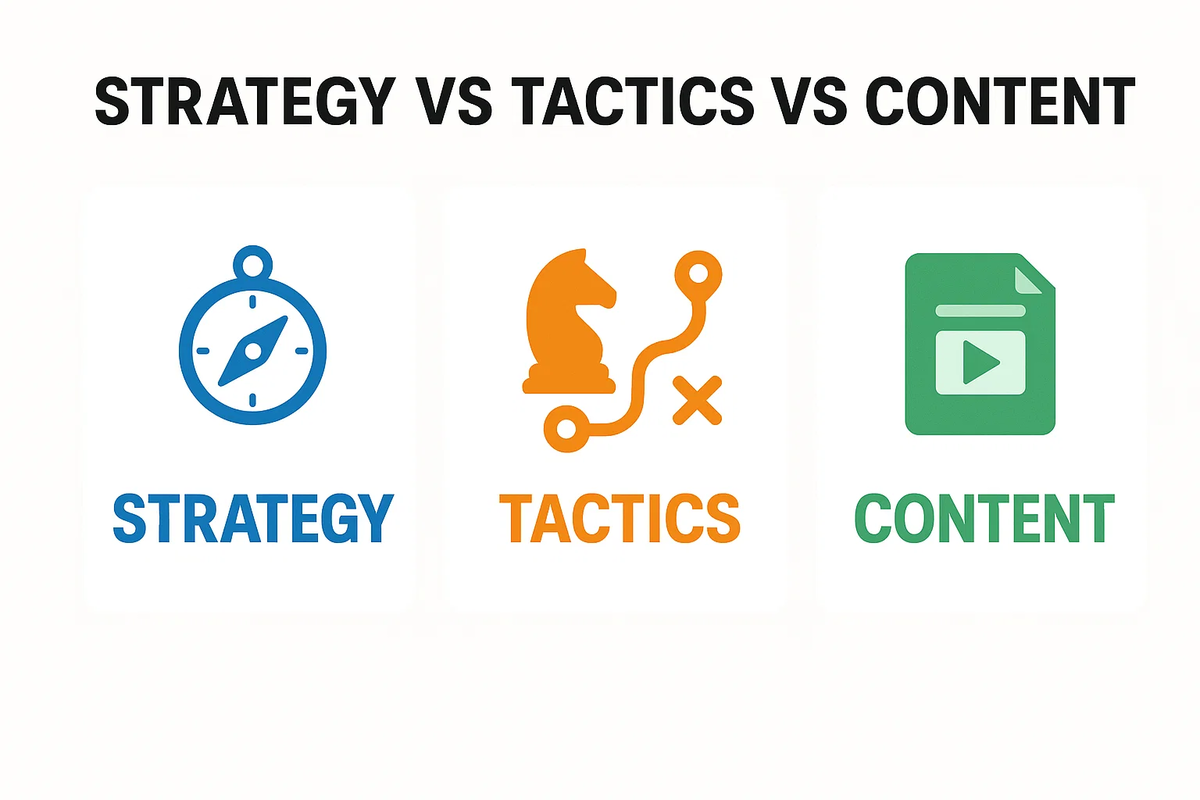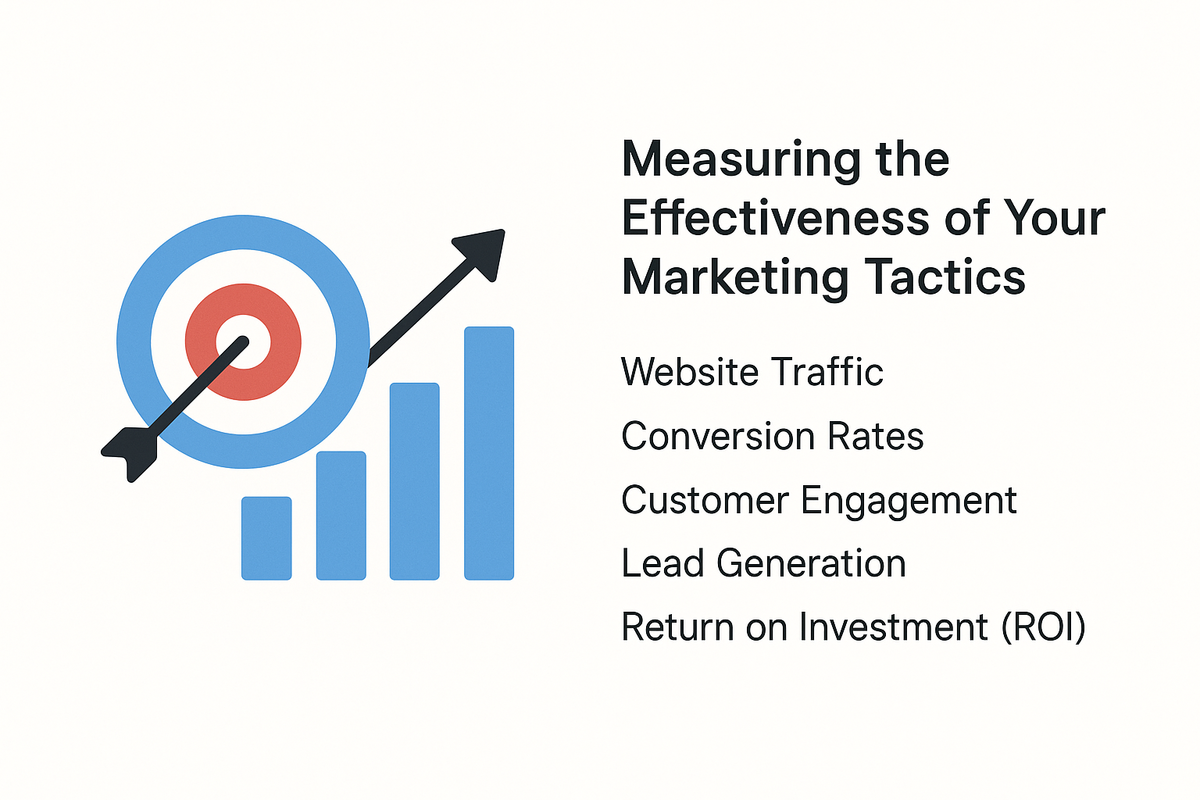To make a real impact in today’s crowded digital landscape, businesses must go beyond basic promotions, they need smart, data-driven marketing tactics that truly connect with their audience.
These tactics are the building blocks that turn big-picture strategies into real-world results.
Whether it’s boosting online visibility with SEO and content marketing or using social media to deepen audience engagement, the right combination of tactics can accelerate brand growth and sharpen your competitive edge.
For a digital transformation company, especially one specializing in web design, SEO, and B2B marketing, choosing the right marketing tactics can mean the difference between stagnant growth and breakthrough performance.
Effective execution can attract high-value leads, enhance the customer journey, and future-proof your business.
In this blog, we’ll break down 15 tried-and-tested marketing tactics that help brands grow smarter, connect deeper with their audience, and thrive in today’s fast-evolving marketplace.
What are Marketing Tactics?
Marketing tactics are the practical, measurable steps companies take to achieve their marketing goals. These actions can include launching paid ads, optimizing content for SEO, building email campaigns, or running promotions on social media.

In short, tactics are how strategies come to life. They are the boots-on-the-ground execution efforts that build brand awareness, drive traffic, acquire customers, and strengthen retention.
Strategy vs Tactics vs Content
When it comes to marketing, the terms strategy, tactics, and content are often used interchangeably, but they play very different roles.

Strategy defines the vision and long-term direction, tactics outline the specific actions that bring that vision to life, and content provides the tools to execute those actions. Understanding how they connect ensures your marketing efforts are both focused and effective.
Let’s clarify three key terms often confused:
| Strategy | Tactics | Content | |
|---|---|---|---|
| Definition | The big-picture vision that outlines why and how you’ll achieve marketing goals over time. | The specific, measurable actions that put your strategy into practice. | The materials and assets used to execute tactics and engage audiences. |
| Purpose | Provides long-term direction and clarity. | Delivers short-term, actionable impact. | Serves as the medium to carry messages and deliver value. |
| Timeframe | Long-term (6–12 months or more). | Short-term (days, weeks, or months). | Varies (created and updated continuously). |
| Focus | Why & Where you’re going | What actions to take | With what tools/messages |
| Example | Goal: Improve lead generation through thought leadership. | Action: Host a monthly webinar to attract leads. | Asset: An eBook given to webinar registrants. |
| Keywords | Vision • Roadmap • Direction | Execution • Measurable • Immediate Impact | Blogs • Videos • Infographics • Whitepapers • Emails |
Explore Our Digital Marketing Services!
15 Effective Marketing Tactics & Strategies for Business Success
Here are the 15 powerful marketing tactics that can drive growth and ensure long-term business success.

1. Optimize Your Website for SEO
Search Engine Optimization (SEO) is one of the most powerful long-term marketing tactics a business can implement.
It focuses on improving your website’s visibility on search engines like Google, helping potential customers find you when searching for relevant products or services.
Key SEO optimization steps include:
- Keyword Research: Identify high-intent keywords that your target audience is searching for, such as "best SEO tools for small businesses" or "high ticket affiliate marketing" opportunities.
- On-Page SEO: Optimize page titles, meta descriptions, headers, and content with relevant keywords.
- Technical SEO: Improve site speed, mobile responsiveness, secure HTTPS, and fix crawl errors.
- Internal Linking: Connect relevant pages within your site to boost navigation and distribute link equity.
- High-Quality Content: Create valuable, keyword-rich content that answers user queries and keeps them engaged.
- Backlink Building: Earn reputable backlinks from authoritative websites to boost domain authority.
- Local SEO: Optimize your site for local searches by claiming your Google Business Profile and using location-based keywords.
When implemented consistently, SEO not only drives qualified traffic but also establishes your brand as a trusted authority in your niche.
2. Boost Your LinkedIn Marketing
As a marketing tactic, focusing on LinkedIn allows businesses to connect directly with decision-makers, showcase expertise, and build meaningful relationships with prospects and partners.
Effective ways to boost your LinkedIn marketing:
- Optimize Your Company Page: Ensure your profile is complete, includes keywords, and clearly explains your value proposition.
- Post Valuable Content Regularly: Share thought leadership posts, client success stories, industry insights, and behind-the-scenes content.
- Engage with Your Network: Comment on posts, respond to messages, and participate in relevant discussions to boost visibility.
- Use LinkedIn Ads: Run targeted ads to reach key roles and industries with precision (sponsored content, InMail, or lead gen forms).
- Leverage Employee Advocacy: Encourage your team to share and engage with company posts to amplify reach and credibility.
- Join and Contribute to Groups: Become active in industry-specific LinkedIn groups to build authority and network organically.
- Track Analytics: Use LinkedIn analytics to assess post performance, audience growth, and engagement trends, and refine accordingly.
Additionally, incorporating an enterprise SEO service can enhance your company’s LinkedIn profile’s search visibility. This service ensures your content is optimized to reach the right audience on LinkedIn, contributing to greater brand awareness and lead generation.
With the right strategy, LinkedIn becomes more than a social network when used strategically. It can transform into a powerful lead generation and relationship-building tool, especially when considering B2B vs B2C marketing approaches.
3. Implement Personalized Email Marketing
Personalized email marketing is a powerful tactic that enables businesses to deliver tailored content to individual recipients, enhancing engagement and driving conversions.
Thus, by leveraging customer data and behavioral insights, marketers can craft messages that resonate personally with each subscriber.
Tailored emails not only capture attention but also foster a sense of connection between the brand and the recipient.
This strategy is often implemented by a B2C web development agency to help their clients increase user retention through personalized digital experiences.
Here’s why personalized emails work:
- Enhanced Engagement: Personalized subject lines can increase open rates, making recipients more likely to read the content.
- Higher Conversion Rates: Emails triggered by specific behaviors, such as cart abandonment, can generate up to 10 times more revenue than standard promotional emails.
- Improved Customer Retention: Personalized experiences can lead to a reduction in customer acquisition and retention costs.
- Increased Revenue: Companies that excel at personalization generate more revenue than those that don’t. With the right strategies, businesses can also benefit from organic SEO services to attract even more potential customers.
Here are some of the key strategies for effective personalized email marketing:
- Segment Your Audience: Divide your email list based on demographics, purchase history, or engagement levels to send more relevant content.
- Utilize Behavioral Triggers: Send emails in response to specific actions, such as browsing certain products or abandoning a cart, to re-engage customers.
- Incorporate Dynamic Content: Use tools that allow email content to change based on the recipient's preferences or past interactions.
- Test and Optimize: Regularly A/B test subject lines, content, and send times to determine what resonates best with your audience.
By implementing personalized email marketing, businesses can create more meaningful connections with their audience, leading to increased loyalty and sales.
4. Amplify Your Brand with Strategic Social Media Marketing
Social media marketing is a dynamic and cost-effective tactic that enables businesses to connect directly with their audience, build brand awareness, and drive conversions.
Here are effective strategies to leverage social media:
- Develop a Clear Social Media Strategy: Define your goals, identify your target audience, and choose the appropriate platforms to focus your efforts
- Create Engaging and Relevant Content: Share content that resonates with your audience, including educational posts, behind-the-scenes glimpses, and user-generated content.
- Utilize Influencer Partnerships: Collaborate with influencers who align with your brand values to expand your reach and credibility.
- Monitor and Analyze Performance: Regularly assess your social media metrics to understand what works and refine your strategy for better results.
- Stay Updated with Trends: Keep an eye on emerging social media trends and adapt your content to stay relevant and engaging. For example, partnering with an oil and gas marketing agency can help businesses in this sector leverage trends effectively.
By implementing these strategies, businesses can harness the power of social media to build a strong online presence, connect with their audience, and drive sustainable growth.
5. Streamline Operations with Marketing Automation
According to McKinsey's 2024 report on AI adoption, organizations are increasingly integrating AI and automation into their operations to drive efficiency and growth.
The report highlights that companies are redesigning workflows and adopting best practices to capture value from generative AI, with more than three-quarters of respondents indicating the use of AI in at least one business function
Here’s how to implement marketing automation effectively:
- Set Clear Goals: Define what you want to achieve (e.g., more leads, better engagement).
- Know Your Audience: Build buyer personas and segment your audience.
- Choose the Right Tool: Pick a platform that fits your business needs and integrates with your systems.
- Integrate with CRM: Connect your automation tool with your CRM and other platforms.
- Create a Content Plan: Develop content for different stages of the customer journey.
- Use Lead Scoring: Prioritize leads based on behavior and engagement.
- Build Automated Workflows: Set up flows like welcome emails, cart abandonment, and re-engagement campaigns.
By implementing marketing automation, businesses can optimize their marketing strategies, deliver consistent messaging across channels, and achieve better alignment between marketing and sales teams.
6. Strengthen Customer Retention with a Strategic Loyalty Program
A report by McKinsey shows that companies that align loyalty programs with pricing strategies can unlock significant growth. For example, offering exclusive promotions to loyalty members can expand the customer base and enhance engagement.
Given this, an effective loyalty program must feature tiered rewards, personalized offers, and easy-to-redeem points. Promoting your program across multiple channels, such as email, social media, and in-store, can drive higher participation and engagement.
Implementing a strategic customer loyalty program involves a structured approach that aligns with your business objectives and customer expectations.
Here are the key steps to guide you through the process:
- Choose the right program model: Select a structure (points, tiers, paid, etc.) that fits your business.
- Integrate the right technology: Use platforms that support tracking, analytics, and personalization.
- Ensure a seamless user experience: Make the program easy to join, use, and engage with.
- Promote across all channels: Market the program through email, social media, and in-store.
- Train your team: Educate staff to encourage sign-ups and support customers.
- Track performance metrics: Monitor KPIs like retention, engagement, and redemption rates.
Moreover, a Deloitte survey shows that 86% of consumers value simplicity and ease of use in loyalty programs, while 80% prioritize flexibility in earning and redeeming rewards.
Book Your Free Expert Consultation
7. Gain a Competitive Edge with Smart Competitor Content Analysis
Conducting competitor content analysis is a strategic marketing tactic that helps you stay ahead by learning from others in your industry.
By regularly reviewing the blogs and content of your competitors, you can identify gaps they’re not addressing, whether it's missing topics, outdated information, shallow insights, or weak engagement strategies.
This process allows you to:
- Spot content gaps that you can fill with more comprehensive or unique insights and identify areas that your competitors are not addressing, such as "what is network marketing" or "what is B2B marketing".
- Differentiate your tone and style to better connect with your target audience
- Deliver more value by going deeper or offering updated, data-backed perspectives
- Benchmark performance to understand what works and where you can do better
- Strengthen your SEO strategy by targeting untapped or poorly targeted keywords
By consistently outperforming competitors in content quality, relevance, and thought leadership, your brand can attract more organic traffic, improve authority in your niche, and build trust with your audience. This is a key tactic for brands aiming to lead, not follow in their industry.
8. Refresh Rankings with Content Updates
Updating existing content is a powerful and often overlooked marketing tactic that keeps your blog relevant, accurate, and competitive.
s industry standards evolve and new data emerges, older posts can quickly become outdated, diminishing both user trust and SEO performance.
Regularly revisiting and refreshing your content allows you to:
- Incorporate the latest data, trends, and best practices
- Improve keyword targeting based on current SEO opportunities
- Fix outdated links, stats, and examples that may harm credibility
- Add new sections or insights to boost content depth and value
- Re-engage readers and search engines with fresh, high-quality material
Additionally, when you focus on enhancing existing content and refining your SEO strategy, you can even uncover how to search for words on a page, which could be beneficial for further optimizing your blog for users.
Search engines reward updated content with better visibility, while users appreciate the accuracy and relevance. This tactic not only improves your site’s authority but also extends the lifespan and ROI of your original content efforts.
9. Build Authority by Engaging in Online Communities
Participating in online communities is a strategic way to expand your reach, boost credibility, and drive qualified traffic to your blog.
Platforms like Reddit, Quora, LinkedIn groups, and niche industry forums provide valuable spaces to share your expertise, answer questions, and contribute meaningfully to ongoing conversations.
When you offer thoughtful, helpful responses backed by knowledge and experience, you:
- Position yourself as a subject-matter expert
- Gain trust and visibility among your target audience
- Create organic opportunities to link to your blog content
- Attract engaged users who are genuinely interested in your niche
- Strengthen your brand’s presence in relevant online spaces
As an example, sharing advertisement examples or case studies within these communities can demonstrate your expertise and drive traffic.
Over time, this consistent value-driven engagement not only drives traffic but also fosters deeper relationships and builds a loyal audience around your brand.
10. Boost SEO with Structured Data and Rich Snippets
Implementing structured data markup (Schema.org) is a high-impact SEO tactic that helps search engines better understand your website’s content.
Therefore, by tagging elements like articles, products, reviews, FAQs, or events with structured data, you provide clear context about what your content represents.
This added clarity can lead to:
- Enhanced search visibility through rich snippets
- Improved click-through rates with more engaging search results
- Increased chances of appearing in featured snippets and other SERP features
- Better indexing and relevance scoring by search engines
- A more professional and authoritative presence in search results
Whether you're running a blog or an eCommerce site, structured data transforms how your content is presented, and perceived, on search engine results pages, making it a must-have for any serious SEO strategy.
For businesses aiming for comprehensive digital growth, working with a digital transformation agency can ensure the integration of structured data into broader SEO strategies.
11. Stay Relevant by Monitoring Industry Trends
Monitoring industry trends ensures your blog remains current, valuable, and aligned with your audience’s expectations.
Why this tactic works:
- Keeps your content up-to-date with changing standards, tools, and market conditions
- Enhances credibility as your blog reflects thought leadership and awareness
- Boosts organic traffic from users searching for the latest developments
- Inspires new content ideas based on market conversations and news
- Increases shareability as timely content is more likely to be referenced or linked
Staying informed on innovations, challenges, and shifts in your sector allows you to create relevant content. \
For instance, understanding how does Shopify work can help you address emerging e-commerce trends, keeping your audience informed and engaged.
12. Drive Targeted Traffic with Paid Advertising
Promoting your blog through paid advertising helps you reach the right audience faster.
Whether through Google Ads or social platforms like Facebook and LinkedIn, paid campaigns give you the ability to target users by intent, demographics, or interests, driving high-quality traffic that’s ready to engage.
Benefits of this tactic:
- Precise audience targeting based on search intent, behavior, or demographic filters
- Quick visibility boost for newly published or cornerstone content
- Increased conversions by directing traffic to specific blog posts or lead magnets
- Full control over budget and performance with real-time optimization
- Highly measurable results using KPIs like CTR, bounce rate, and cost per click
Moreover, utilizing tools such as keyword ranking report software can help track the effectiveness of your paid campaigns, providing insights into which keywords are driving the best traffic to your blog.
13. Expand Reach by Collaborating with Influencers
Influencers can amplify your brand by tapping into trusted relationships with their followers. When they share or reference your blog content, it not only drives traffic but also lends credibility.
Collaborating with influencers that align with your brand values can lead to long-term trust and brand loyalty.
Here are the best practices for successful influencer collaborations:
Prioritize Authenticity: Let influencers speak in their own voice, audiences respond best to honest, natural endorsements.
Use Written Agreements: Always have a contract outlining scope, compensation, posting schedule, and brand guidelines.
Leverage Micro-Influencers: Micro-influencers (10K–100K followers) often have higher engagement and more niche authority.
Most importantly, treat influencers as long-term brand partners, not just promotional tools for stronger collaboration and loyalty.
If you're in the digital marketing space, influencers can help you reach more customers and build trust. For instance, understanding Google Ads cost and how to target the right keywords can also be improved by working with influencers who excel in paid media.
14. Establish Authority with Comprehensive Pillar Pages
Pillar pages act as the central hub for a topic, linking to and from all related content on your site. They improve both SEO and user experience by organizing content clearly and demonstrating expertise on core subjects.
How pillar pages support growth:
- Strengthen SEO with structured internal linking and keyword clustering
- Improve content discoverability through easy-to-navigate topic hierarchies
- Encourage deeper engagement by offering related subtopics in one place
- Build topical authority in the eyes of both users and search engines
- Provide long-form, high-value content that keeps readers on your site longer
If you’re looking to optimize pillar pages further, using the "noindex" tag on non-essential pages can ensure that search engines focus on the most valuable content. Also, understanding what is the digital marketing strategy that tracks users across the web? can help tailor your pillar page content to align with broader marketing strategies.
15. Encourage User-Generated Content (UGC) to Build Trust
User-Generated Content (UGC) refers to any content, such as photos, reviews, testimonials, or social media posts created by your customers or audience.
Encouraging UGC allows your brand to showcase real experiences, build trust, and strengthen your community while organically promoting your blog or product.
For eCommerce businesses, leveraging UGC can also enhance your SEO efforts, and integrating services like eCommerce SEO can maximize the impact of such content.
How to implement it:
- Create branded hashtags to collect posts (e.g., #MyBlogStory or #YourBrandNameStyle).
- Host contests or challenges to incentivize participation.
- Request testimonials or reviews and showcase them on your site.
- Feature user stories in blog posts or social media shoutouts.
- Engage with user content by liking, commenting, and reposting (with permission).
When customers feel like they’re part of your brand story, they become more than just followers, they become advocates.
Measuring the Effectiveness of Your Marketing Tactics
To ensure your marketing tactics are yielding results, it's essential to track and measure their performance.

This becomes even more crucial for businesses offering ecommerce development services, where digital touchpoints directly impact conversions.
Here are key metrics to consider:
- Website Traffic: Track the number of visitors and their sources to understand how well your campaigns are driving traffic.
- Conversion Rates: Monitor the percentage of visitors who complete a desired action, such as making a purchase or subscribing to a newsletter.
- Customer Engagement: Measure how actively your audience interacts with your content, such as through likes, shares, and comments on social media.
- Lead Generation: Evaluate the quantity and quality of leads generated from your marketing efforts.
- Return on Investment (ROI): Calculate the ROI of your marketing tactics to gauge their profitability and overall effectiveness.
FAQs: Best Marketing Tactics That Work
What are some marketing tactics examples businesses can use today?
Some effective marketing tactics examples include SEO optimization, social media campaigns, influencer collaborations, email marketing, paid advertising, and customer loyalty programs. These tactics of marketing help brands connect with audiences, generate leads, and drive consistent growth.
What is the difference between strategy and tactics in marketing?
A strategy is the overall roadmap for achieving long-term goals, while a marketing tactic is the specific action taken to implement that strategy. For example, if your strategy is to boost brand authority, one of the best marketing tactics could be publishing thought leadership blogs or hosting webinars.
What should be included in a marketing tactics list?
A strong marketing tactics list can include SEO, content marketing, LinkedIn marketing, personalized emails, paid ads, loyalty programs, influencer partnerships, and community engagement. The right mix of tactics marketing depends on your audience, industry, and business goals.
What are the best marketing tactics for B2B companies?
For B2B, the best marketing tactics often involve LinkedIn marketing, content-driven SEO, webinars, case studies, and account-based marketing. These tactics of marketing focus on building trust, showcasing expertise, and nurturing long-term client relationships.
How do I choose the right marketing tactic for my business?
The right marketing tactic depends on your target audience, budget, and objectives. Start by analyzing customer behavior, industry trends, and competitors, then select tactics marketing like SEO, email campaigns, or influencer outreach that best align with your growth goals.
Why is it important to regularly update your marketing tactics list?
Digital landscapes evolve quickly, so refreshing your marketing tactics list ensures you stay competitive. Updating tactics, such as improving SEO, adopting automation, or exploring new social platforms, keeps your brand relevant and maximizes ROI from your tactics of marketing.
Conclusion
In today’s fast-paced digital world, standing out with your blog takes more than just good writing, it takes smart, intentional marketing tactics.
Whether it's optimizing for SEO, sharing great content on social media, or building an email list, every little step helps boost your blog’s reach and engagement.
Keeping your content fresh, teaming up with influencers, and digging into analytics all play a big part in staying relevant and making a real impact.
When you combine these efforts into a well-rounded strategy, you’ll not only drive more traffic but also build stronger connections with your audience and turn readers into loyal followers.
At the end of the day, success doesn’t come from a one-time push, it comes from staying consistent, listening to your audience, and always being ready to adapt as the digital world evolves.









